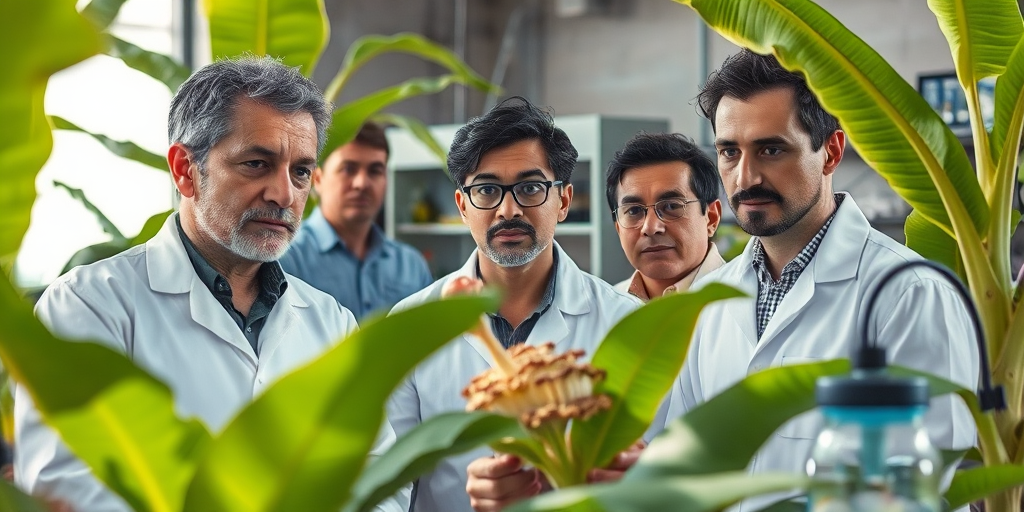Diverse Lasiodiplodia Species Threaten Banana Crops in Brazil
In a significant breakthrough, researchers have revealed substantial findings on the diversity and pathogenic capabilities of Lasiodiplodia species linked to banana crown rot in Brazil’s northern and northeastern regions. This postharvest disease is causing severe economic losses by deteriorating the quality of bananas, a primary staple in Brazil, and has prompted urgent discussions on developing comprehensive disease management strategies.
Understanding Banana Crown Rot
Banana crown rot is a prominent disease affecting bananas after harvest, characterized by darkening and softening of the fruit, which severely impacts marketability. The recent study, published in Scientific Reports, is the first of its kind to conduct an extensive survey of Lasiodiplodia species diversity associated with this disease in Brazil. The implications are profound for local farmers and the broader banana industry, the latter contributing significantly to Brazil’s economy.
Dr. Kevison Romulo da Silva França, leading the study at the Federal University of Alagoas, highlighted, “The diversity and pathogenicity of these Lasiodiplodia species have never been explored in such detail in Brazil. Understanding these pathogens at a molecular level is essential for developing effective strategies to mitigate banana losses.”
Research Findings
The study identified six species of Lasiodiplodia through morphological and multigene phylogenetic analysis: Lasiodiplodia brasiliensis, L. hormozganensis, L. iraniensis, L. laeliocattleyae, L. pseudotheobromae, and L. theobromae. A total of 116 fungal isolates were collected from bananas exhibiting crown rot symptoms across 10 Brazilian states. This diversity was unexpected, revealing a complex community of pathogens threatening banana cultivation.
Pathogenicity tests confirmed the ability of all species to induce crown rot symptoms in banana cultivars common to Brazil. However, Lasiodiplodia theobromae emerged as the predominant species, widespread across most sampled sites except for Acre, Northern Brazil. Researchers suggest that L. theobromae’s ecological adaptability and dispersal capabilities far exceed those of other Lasiodiplodia species.
Local Impact and Community Interest
Banana production is integral to Brazil’s agricultural economy, particularly in the north and northeast regions, which account for nearly half of the country’s output. As such, the study’s findings bear significant implications for local farmers who rely on banana cultivation for their livelihoods.
Local farmer Maria Oliveira from Bahia expressed concerns about how these pathogens could impact future yields, stating, “We’re already facing so many challenges with weather and market prices; we can’t afford to lose more to diseases.” Her sentiments resonate with numerous residents in banana-producing regions, highlighting the urgent need for sustainable solutions.
Historical Context and Future Implications
Historically, Brazil has battled various plant diseases, but the expanding understanding of Lasiodiplodia species introduces new complexities. In a region already grappling with climate challenges and economic pressures, such findings complicate the agricultural framework, necessitating a more strategic approach to pest control and crop management.
The implications of this study unfold beyond agriculture alone. As Dr. Mayra Machado de Medeiros Ferro, a co-author of the study, points out, “Implementing better disease management strategies will not only help save crops but also improve the economic stability of these regions, empowering local communities.”
This raises broader questions about the intersection of agricultural practices, economic policies, and climate adaptation strategies, which need comprehensive addressing to safeguard the region’s agricultural future.
Ensuring Community Resilience
Moving forward, researchers emphasize the relevance of integrating morphological, molecular, and phylogenetic data to enhance species identification techniques further. This integration will be pivotal in equipping farmers and agricultural extension agents with the knowledge and tools necessary to tackle these pathogens.
For local stakeholders wondering about actionable steps forward, resources such as workshops, forums, and collaborative research initiatives are essential. By implementing these knowledge-sharing and support systems, communities can develop locally adapted, sustainable solutions to reduce the impact of these pathogens.
Resources and Contact
Residents and stakeholders interested in contributing to or learning more about the ongoing research initiatives are encouraged to contact the Federal University of Alagoas via email at kevison.franca@ceca.ufal.br. Through collaborative action and informed developments, the aim is to transform these findings into practical solutions to bolster the resilience and productivity of banana production in Brazil’s northern states.
The study’s unveiling is a call to action, signaling a time for decisive policy and collaborative research efforts to ensure the future vitality of one of Brazil’s key agricultural sectors.







